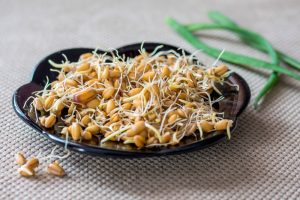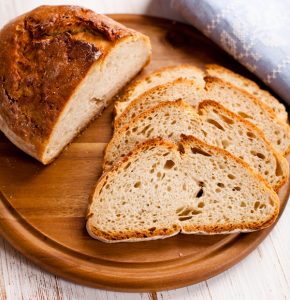What Is Sprouted Grain Bread, and How Healthy Is It?
Sprouted grain bread—made from a variety of sprouted whole grains and legumes—is a rising star in the world of baked goods. Here’s everything you need to know about what may be the best bread for your health.
What do you call a breadless sandwich? Boring, that’s what. If you’re like us and you struggle to imagine a life without bread, don’t panic. We’ve found a healthy option to help satisfy that carb craving—sprouted grain bread. High in good things like fiber and nutrients and free from bad stuff like sugar, here’s why sprouted grain bread should be your top toast choice.
Is Sprouted Grain Bread Healthy?
It can be, depending on your health needs and goals, says Lauren Minchen, MPH, RDN, CDN, a New York-based Registered Dietitian.
WHAT’S IN A NAME?
Sprouted grain bread is also known as “bible bread” or “manna bread.” Legend has it that it was named after a bread mentioned in Ezekiel 4:9 in the bible: “Take thou also unto thee wheat and barley and beans, and lentils and millet and fitches, and put them in one vessel, and make thee bread thereof.”
Sprouted grain bread is made from a variety of organic sprouted whole grains (including wheat, millet, barley, and spelt) and legumes (including soybeans and lentils). Its rich nutrients and high fiber and protein content make it a much healthier option than white breads, which are made from refined wheat flour. sprouted grain bread is “a less processed, more nutrient-dense bread that also tends to be more satisfying,” says Minchen.
Another health bonus: Sprouted grain bread doesn’t contain sugar, preservatives, or artificial ingredients, which plague most other types of commercially made bread. It’s also low in calories (for a bread). To learn more about healthy bread options, read our post Healthy Bread: Is There Such a Thing?

Calorie count in one slice of Food for Life’s sprouted grain bread: a mere 80. (Photo courtesy of Food for Life)
What’s in Sprouted Grain Bread?
According to Food for Life, one of the main manufacturers of sprouted grain bread, each loaf contains the following all-natural ingredients:
- Organic sprouted wheat
- Filtered water
- Organic sprouted barley
- Organic sprouted millet
- Organic malted barley
- Organic sprouted lentils
- Organic sprouted soybeans
- Organic sprouted spelt
- Fresh yeast
- Organic wheat gluten
- Sea salt
SPROUTED GRAIN BREAD RECIPES
Are you the DIY type who’s anxious to give sprouted grain bread a try? Here are three recipes from reputable sources:
One 34 g slice of Food for Life’s sprouted grain bread has:
- 80 calories
- 3 g of fiber
- 15 g of total carbs
- 0.5 g of fat
- 75 mg of sodium
- 4 g of protein
- 80 mg of potassium
- 0 g of sugar
What Are “Sprouted” Grains?
Sprouted grains have been soaked until they germinate. This process enriches the wheat, which in turn ups the levels of nutrients and lowers carbohydrates. According Minchen, “Sprouted grains are more easily digested, and the nutrients are better absorbed than traditional whole grain and refined grain breads.”

Sprouted grains: a key ingredient in sprouted grain bread. (Photo: © Volodymyr Muliar | Dreamstime.com)
Sprouted grains, Minchen adds, “are closer to their natural form [at harvesting] than refined wheat flour.”
One reason for this increased nutrient absorption: the breakdown of antinutrients, which are naturally occurring chemicals designed to protect the grain or legume by deterring animals from eating it. The sprouting process reduces the amount of these protective chemicals, which prevent the absorption of nutrients and can hinder digestive enzymes. Take raw soybeans, for example—they’re toxic in their natural state.
Need another reason to eat sprouted bread? We’ll give you three, according to researchers of studies published in the Journal of Agricultural and Food Chemistry and the International Journal of Food Sciences and Nutrition. Sprouting increases the amount of:
- Antioxidants (e.g., vitamins C, E, and beta-carotene)
- Soluble dietary fiber
- Protein
Is Sprouted Grain Bread Carb-Free?
You saw the word bread here, right? That means it’s not carb-free (darn!). But, Minchen notes, “It’s a moderate source of carbs. About one [carb] serving per serving of bread [two slices].”
So, if you’re on a carb-restricted diet, sprouted grain bread isn’t the panacea you’re looking for. If you aren’t watching your carbs or your waistline, feel free to indulge. All of those extra nutrients and fiber should help alleviate some of the associated bread guilt.
SOURCES & RESOURCES
For related reading, please visit these posts:
Is Sprouted Grain Bread Healthier Than Whole Wheat Bread?
Yes, says Minchen. As mentioned earlier, sprouted grain bread is more nutrient-rich than other types of bread—even the whole grain kind. “This translates to consuming more vitamins and minerals and trace nutrients from sprouted grain bread,” she explains, “than from a traditional whole grain bread.”
Is Sprouted Grain Bread Gluten-Free?
No. While sprouting can slightly reduce the levels of gluten in sprouted grain bread bread, it does not eliminate them. Regardless of the sprouting process, sprouted grain bread contains wheat, barley, and spelt, all of which contain gluten. Those who suffer from celiac disease or a gluten intolerance should avoid eating sprouted grain bread or should attempt to bake a gluten-free version at home.
Is Sprouted Grain Bread Good for Weight Loss?
“This would depend on an individual’s health status,” says Minchen. “But generally speaking, sprouted grain bread is a great choice.”
That said, remember that sprouted grain bread, as healthy as it seems, still contains calories and carbs. Overdoing it won’t help you fit back into those jeans. “I would recommend that no matter what bread you’re consuming, you balance it with other whole food carbs and limit it to two slices per day,” suggests Minchen.

Sourdough bread (pictured) and sprouted grain bread typically appear at or near the top of “healthiest breads” lists. (Photo: © Barol16 | Dreamstime.com)
SOURDOUGH: THE OTHER HEALTHY BREAD CHOICE
Sourdough bread, in addition to tasting tangy and delicious, is easier on the stomach than other types of bread. Its long fermenting process causes the flour’s vitamins and minerals to break down into a more digestible product.
Sourdough is also lower on our glycemic index than other breads, which means its naturally occurring glucose is released slowly into the blood stream. Another plus: It’s less likely to cause food intolerance.
To learn more, read our post Sourdough Bread Health Benefits Make It the Best Bread Choice.
This article was originally published in 2018. It is regularly updated.


 Ask the EN Experts March 2025
Ask the EN Experts March 2025  Vegan Diet Better Than Omnivore Diet for Cardiovascular Health
Vegan Diet Better Than Omnivore Diet for Cardiovascular Health 
Love manna? Make it Ezekiel bread, high in fiber and nutrients and free from sugar.
© Photoeuphoria | Dreamstime.com